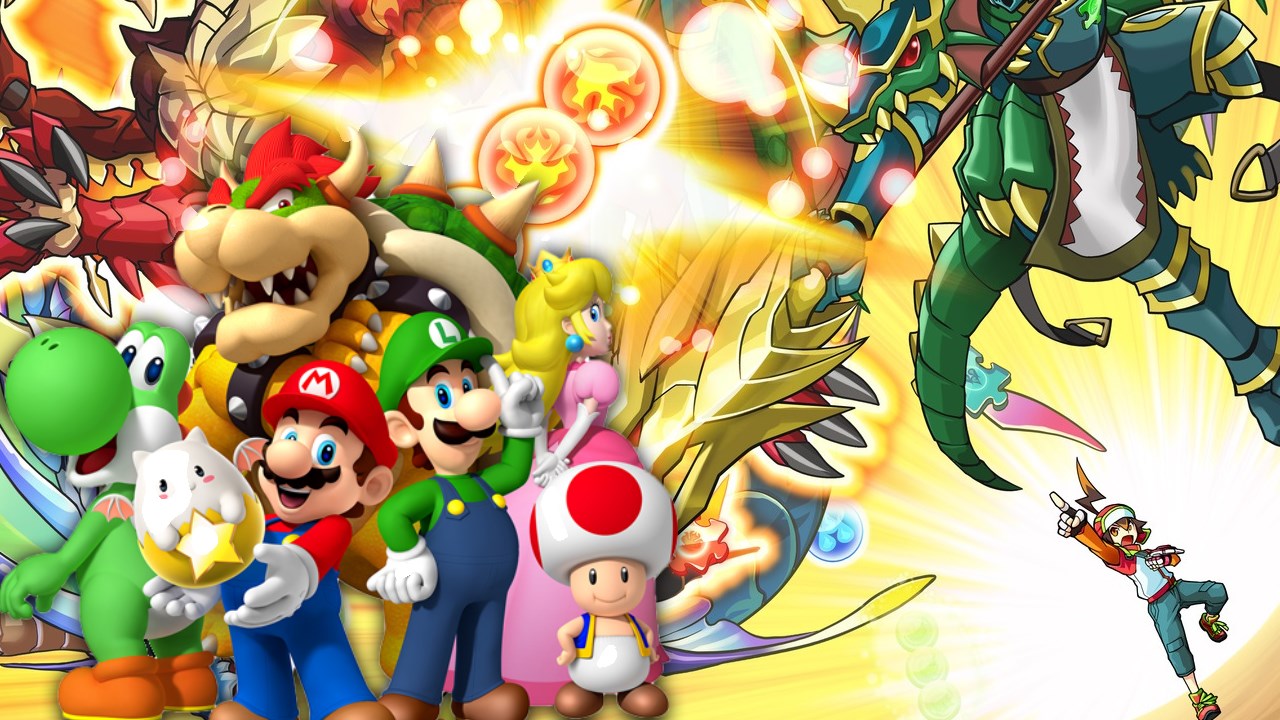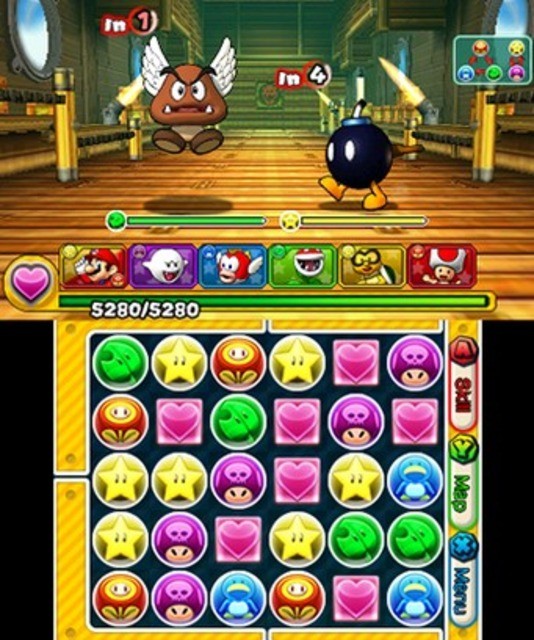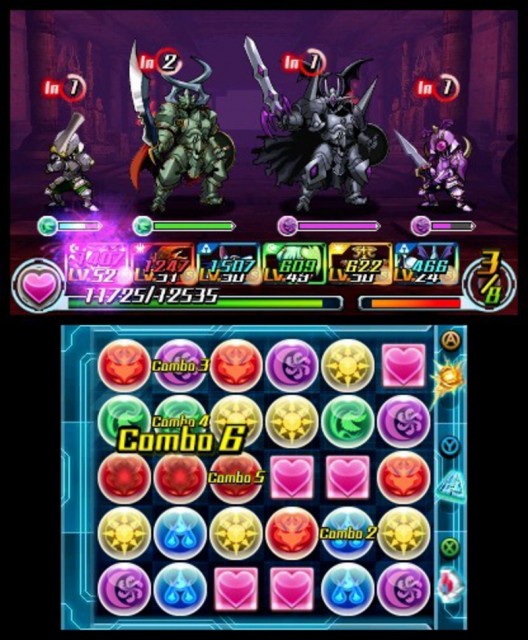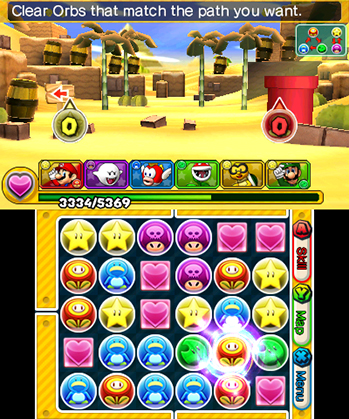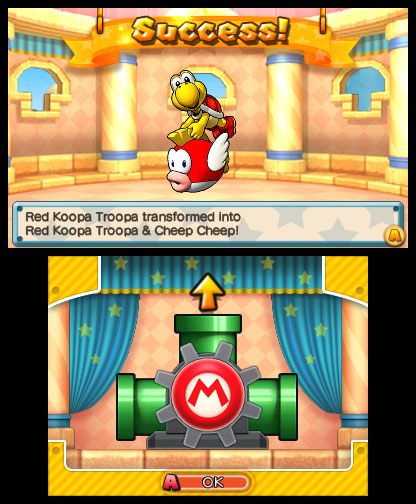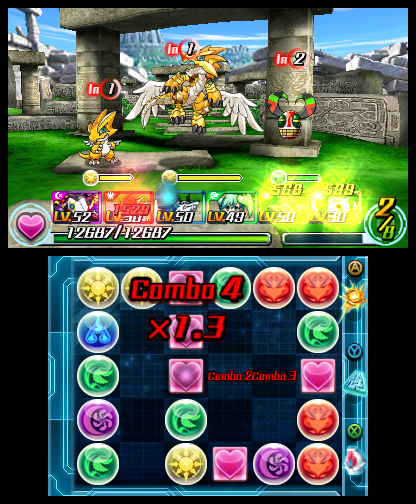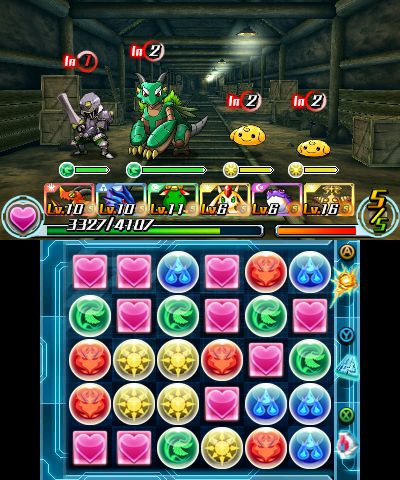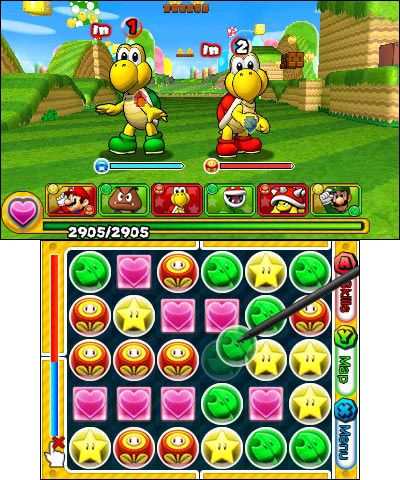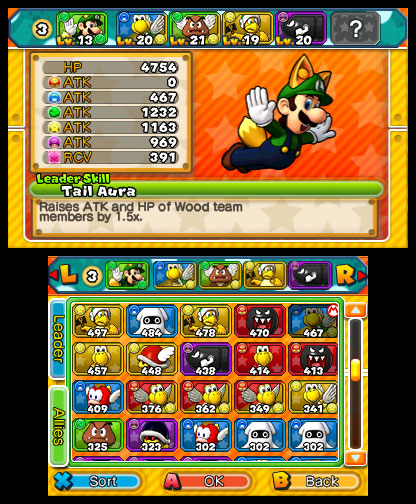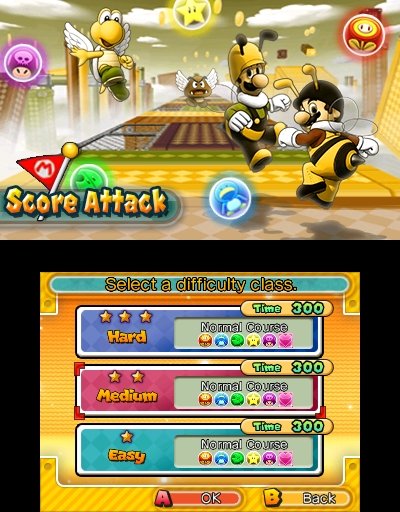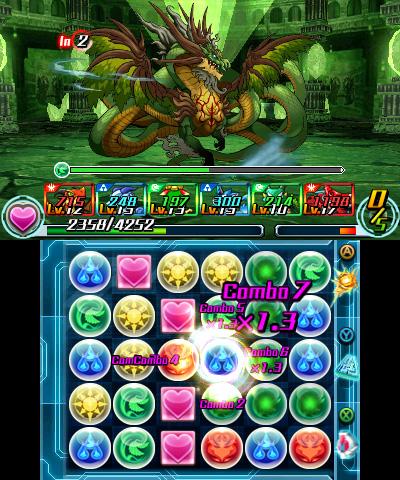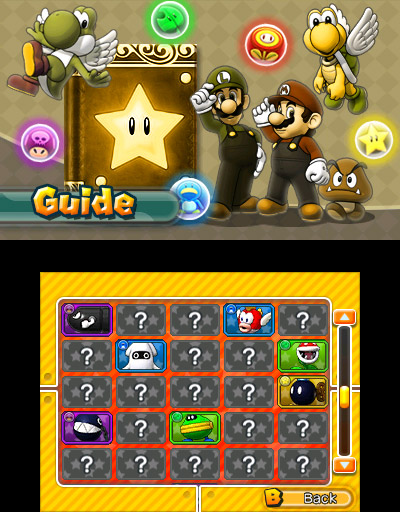Mobile gaming might be seen as a den of low game quality, dishonest business practices, and a user base mostly consisting of unassuming non-gamers that are oblivious to the heaps of clones, scams and skeleton games on the App Store and Google Play Store here in the West, but in Japan, mobile gaming is a massive business that extends to even hardcore gamers. At the top of this mobile gaming craze in the Land of the Rising Sun, is Puzzle & Dragons, a Pokemon-styled riff on the Puzzle Quest RPG/puzzler mashup that was pioneered beforehand, which is one of the region’s top-selling and most beloved mobile games.
Eventually, Puzzle & Dragons got a spin-off on the 3DS, Puzzle & Dragons Z, which was initially denied release in Western territories. When it came time to cross over the ever-beloved Mario franchise with Puzzle & Dragons in 2015 however, Nintendo decided to try their luck with the Puzzle & Dragons brand in North America and PAL territories. In fact, not only did Puzzle & Dragons: Super Mario Bros. Edition release here, but it was also bundled with the formerly-unavailable Puzzle & Dragons Z to boot, with both games packaged together at both retail and on the 3DS eShop, for a discounted $34.99 price.
In terms of value, Puzzle & Dragons Z + Puzzle & Dragons: Super Mario Bros. Edition is a strong proposition for avid fans of puzzlers, especially match-three puzzlers. RPG fans are probably better off skipping even this combined package though, since they have tons of better options in the 3DS library, particularly with the ugly freemium roots of Puzzle & Dragons being pretty evident in both games. Design quibbles, poor gameplay balance and a high learning curve sadly drag down both game offerings from being truly as great as they could be, though if you have a lot of patience, and particularly enjoy wracking your brain on devious puzzles, you’ll find some solid amusement nonetheless.
Neither Puzzle & Dragons game looks all that outstanding for 3DS standards, though at least they’re both colourful and reasonably enjoyable to look at. There’s even a nice bit of flash achieved when you do things like line up enhanced Z Orbs and unleash especially strong special attacks, which engulf the 3D Screen in dazzling fireworks displays that celebrate your puzzle prowess. These particularly leap off of the screen when the 3D Slider is cranked up too, giving Puzzle & Dragons Z + Puzzle & Dragons: Super Mario Bros. Edition noticeably more energy than the majority of puzzle games.
The rest of the games’ visuals however look pretty modest, though certainly not bad. Puzzle & Dragons: Super Mario Bros. Edition is the more visually polished of the two, replicating some of the field sprites and map designs from 2012’s New Super Mario Bros. 2 pretty well, and having lively creature designs that ooze that undeniable Mario charm. The recognizable faces and features of the Mario games make Puzzle & Dragons: Super Mario Bros. Edition feel authentic as an offbeat Mario series entry, and re-arranging orbs that take the forms of things like Fire Flowers, Starmen, Poison Shrooms, and Penguin Suits feels very enjoyable, and very distinctly Mario in style. The pencil-heavy stylings of the art design still help to keep everything in the realm of Puzzle & Dragons as well though, making the art style a win on both counts, even if it’s certainly not the prettiest Mario game to grace the 3DS library to date.
Puzzle & Dragons Z meanwhile looks respectable as the series’ first proper move to 3DS, having lively and detailed anime-style artwork between the creature designs, environments, orbs and character sprites. As with Puzzle & Dragons: Super Mario Bros. Edition, Puzzle & Dragons Z is vibrant and appealing to look at, and the game has plenty of personality. That said though, the field sprites look overly simplistic, and feel like they belong on the Game Boy Advance. Likewise, while the advanced creatures in the game look incredibly cool and beautifully detailed, a lot of the basic ones are dull and unremarkable in design, feeling like second-rate JRPG monster knock-offs. At least the improvements to the visual design of your monsters creates more incentive to enhance and evolve them though.
As for the 3D effects, beyond the aforementioned fireworks displays, they’re pretty good, particularly in how both games use them to showcase environments that appear to stretch into the distance as you move through stages. Since you’ll spend most of the game looking at the Touch Screen, the 3D effects don’t always feel wholly necessary, and those playing on a 2DS, or simply opting to flick off the 3D Slider, really won’t be missing anything. The way that 3D is used with special attacks is clever though, and the 3D does strike a good balance between being stylish without being intrusive.
Both games are a slight cut above the original mobile version of Puzzle & Dragons in terms of visuals, and both of them make commendable efforts to take advantage of the increased scope offered in the move to 3DS. Neither of the games are visual showstoppers, but their personality and charm is nonetheless captured well on Nintendo’s current handhelds.
The audio suite is where Puzzle & Dragons Z often gains the upper hand over Puzzle & Dragons: Super Mario Bros. Edition from a technical standpoint. The riveting, adventurous music and sound effects throughout Puzzle & Dragons Z makes the game feel surprisingly lively and grand in spectacle, which you wouldn’t expect from a game driven primarily by match-three puzzles. The fun battle themes give a great sense of vigor and determination as you frantically try to rearrange orbs in just the right fashion to take down your enemies, just as the background tunes of things like plains, canyons, caverns and temples all perfectly suit their environments, while still popping with the personality of any strong JRPG soundtrack.
Puzzle & Dragons: Super Mario Bros. Edition meanwhile is far less noteworthy in the audio department. The game rips most of its audio assets, from music to sound effects to voice clips, straight from New Super Mario Bros. 2, virtually unaltered. There are a handful of original music compositions that are at least passable, even if they sometimes don’t mesh with the rest of the New Super Mario Bros. 2 tunes serving as BGM, but almost every sound effect is one you’ve heard in most of the modern mainline Mario games, and that includes Mario and Luigi’s occasional exclamations of delight. On the one hand, this continues to help Puzzle & Dragons: Super Mario Bros. Edition feel like a truly authentic Mario spin-off, but on the flip side, the blatant re-using of audio assets from New Super Mario Bros. 2 especially does sometimes come off as lazy.
For what the audio occasionally lacks in technical prowess though, especially in Puzzle & Dragons: Super Mario Bros. Edition, it definitely makes up for in charm. Puzzle & Dragons Z successfully captures the feeling of being on a true JRPG adventure, just as Puzzle & Dragons: Super Mario Bros. Edition will quickly make Mario fans feel right at home with its presentation. Plugging in a pair of headphones is often ideal for the music, as both games sometimes have music with fuzzy, poorly-rendered sections if it’s just played out of the 3DS/2DS speakers at a certain volume, but for the most part, the audio of both games is fun and satisfactory, even if Puzzle & Dragons Z certainly aims a lot higher with its audio selection.
Regardless of which of the two games you play, the fundamental idea behind both is more or less the same, and if you’ve already played the original Puzzle & Dragons on an iOS or Android device, then you’ll already be aware of the fundamentals.
As with the original mobile game, both Puzzle & Dragons Z and Puzzle & Dragons: Super Mario Bros. Edition have players assembling a customized squad of monsters, with a ‘Leader’ that can grant them a special attribute, along with a ‘Helper’ that can grant another attribute, as well as assist in attacks when you match orbs with their selective elemental affinity. In Puzzle & Dragons Z, Leaders can be any old monster you choose, while Helpers are human allies that you can meet in the story, or ally with using StreetPass tags (granting a tag’s preferred ‘Leader’ monster to fill the role of your ‘Helper’ monster when selected), but in Puzzle & Dragons: Super Mario Bros. Edition, Leaders consist of specialized Mario personalities that you recruit as you beat stages, including various forms of Mario, Luigi, Toad or Yoshi, who also serve as Helpers to boot.
Pokemon fans will most quickly get used to this demand of recruiting, leveling up and training/upgrading allies, as you build a custom team of various elemental affinities. As with Pokemon, type-matching is often crucial in Puzzle & Dragons overall, as the main gameplay tactic involves matching three coloured orbs using the stylus and Touch Screen to perform attacks on your foes. The catch is, only monsters that share an element with the three orbs you matched will attack, with elements including Fire, Wood, Water, Light, and Dark. Light and Dark are weak against one another, with Fire being strong to Wood and weak to Water, while Water is strong to Fire and weak to Wood, and Wood is weak to Fire, but strong to Water. These elemental politics are pretty simple to understand, even for newcomers.
From there though, Puzzle & Dragons presents a considerable learning curve. Taken individually, the fundamentals of the game make sense, but both games tend to throw a lot of rules at players very quickly, particularly Puzzle & Dragons Z, which can be tough to keep track of at first. You’ll probably bypass a handful of stages, and get stuck on a few, before you even begin to grasp how to properly strategize at either game, and perhaps both games would have benefited from adjustable difficulty, or more in-depth teaching tools that didn’t wait until absurdly late in the game to give you some vital strategic tips that are necessary to understand if you want to play well. Puzzle & Dragons: Super Mario Bros. Edition is especially guilty of this, with some gameplay fundamentals recounted to me as late as World 5, just over halfway through the main adventure! By then, you would have been forced to discover those tips on your own, making them rather unhelpful at that point.
Once you get past the initially obtuse level of gameplay depth that Puzzle & Dragons demands to play competently however, the game will settle into a groove that players shouldn’t have too hard a time on, especially in the case of Puzzle & Dragons Z, which is simultaneously the more complex game, yet also somehow the easier game. Eventually, you’ll get into a rhythm of building up your favoured team of monsters and Leaders/Helpers, while developing and upgrading them, and learning tips and tricks for how to maximize your attack potential. Towards the end of the game, monsters in Puzzle & Dragons: Super Mario Bros. Edition especially become quite powerful, necessitating a pretty strong pedigree with match-three puzzlers to stand a chance later in the game, especially if you’re under-leveled. This is why Puzzle & Dragons Z + Puzzle & Dragons: Super Mario Bros. Edition demands quite a lot of patience, and quite an avid love of match-three puzzlers.
Once you become good at striking up combos and chains though, battling becomes a lot more manageable, even if the combination of orbs you get to match on the Touch Screen is dictated solely by luck (and slightly by a handful of monster skills that can be charged and unleashed after a certain count of turns), which can sadly make or break battles at times. The advantage to Puzzle & Dragons however is that you can drag any orb freely around the Touch Screen, swapping around whichever orbs you touch, until you lift the stylus from the screen, or until a short time limit expires. This free movement gives you lots of strategic depth in terms of arranging the necessary orb chains to do any real damage to your opponents, and makes battles far more exciting, which is why it’s baffling that either game doesn’t do a better job of effectively impressing upon you that you can do this, and need to do this. Just before the halfway point of both games, it becomes pretty much essential to be good at combos and chains, which is another reason why getting a bad combination of orbs can be very frustrating.
It’s also worth noting that some of the monster management mechanics are different between Puzzle & Dragons Z and Puzzle & Dragons: Super Mario Bros. Edition, with the difference in Leader/Helper mechanics being the first example, even if the fundamental gameplay of both games is the same. In Puzzle & Dragons Z for example, you’re sometimes given Eggs that you can bring back to the hub lab in Z City, which hatch into new monsters, and can even be injected with consumable D-Voltage to potentially hatch into far stronger monsters than they would otherwise. Unhatched Eggs can also be fed to your established and favoured monsters in order to make them stronger as well. Likewise, evolving monsters into new and more powerful forms involves collecting ‘Chips’ dropped by certain strains of enemies, which are fastened together in a simple jigsaw puzzle-like arrangement. While most of these mechanics are well and good, the idea of having to run Eggs back to Z City to get new monsters is annoying, and feels like a pointless extra step. Likewise, the D-Voltage mechanic really doesn’t feel necessary, and you can probably get through the bulk of the game without ever using it, especially when you can just feed unhatched Eggs to monsters that you want to make more powerful anyway.
Puzzle & Dragons: Super Mario Bros. Edition meanwhile does away with the ‘Egg’ mechanic, which is good, and simply has monsters automatically join you whenever you collect elemental ‘Blocks’ after a stage. You still have to go back to Toad Houses at the start of each World Map to evolve monsters however, though you can either do this on foot, or via a few Touch Screen commands. The mechanics in Puzzle & Dragons: Super Mario Bros. Edition feel more refined and streamlined in contrast to Puzzle & Dragons Z overall in fact, which is good, since it’s the more challenging of the two games, surprisingly. Puzzle & Dragons: Super Mario Bros. Edition simply allows you to feed unwanted monsters to strengthen your preferred monsters directly, and rather than find monster-themed Chips, you instead find certain recognizable Mario series items like Fire Flowers, Super Mushrooms, Super Leaves, and Star Coins to evolve your monsters, and improve their skills.
This streamlined monster management setup is far more appealing, especially when you can eventually spend Coins that you earn from stages to try your luck at a set of three mystery boxes to tap, which will give you a random item. For some bizarre reason though, you don’t unlock this capability until about midway through the game, which is inexplicable. Likewise, getting random items simply necessitates more grinding when you inevitably don’t get the items you want in a given area, and yet again, whether you get the right items in a stage depends on luck. It might have been better if the game had simply offered a straightforward Item Shop that let players spend Coins to buy whatever they needed to evolve their monsters, which would have made monster development a whole lot more accessible, and would have opened up Puzzle & Dragons: Super Mario Bros. Edition to people with less than a saint’s patience. As it stands, the game still strangely feels like it’s designing itself for a mobile device.
In fact, that’s one of the greatest Achilles’ heels of both Puzzle & Dragons Z and Puzzle & Dragons: Super Mario Bros. Edition; Both games still feel like they’re mostly designed for a smartphone, not the 3DS library. Both mobile platforms and the 3DS platform have very different audiences, and many 3DS gamers probably won’t have the patience to put up with some of the game’s needless hoops that would be more forgivable to jump through in the mobile space. Puzzle & Dragons is a freemium game on iOS and Android, and that’s why it’s structured the way it is; To motivate players to spend money on microtransactions for extra chances and resources. Puzzle & Dragons Z and Puzzle & Dragons: Super Mario Bros. Edition aren’t freemium games though, and neither feature microtransactions, so they really don’t have an excuse to be as occasionally tedious as they are.
What do I mean by this? Well, on top of both games having unwelcome difficulty spikes, Puzzle & Dragons: Super Mario Bros. Edition especially, the fact that garnering resources is based so heavily on luck, will just have many players feeling like the game is deliberately wasting their time, and needlessly restricting the flexibility of monster development, especially when the 3DS has games like Pokemon and Yo-Kai Watch to better scratch that itch. These monster development resources become crucial for boss fights especially as well, which is where both games, Puzzle & Dragons: Super Mario Bros. Edition especially, often have their most unwelcome difficulty spikes. Most of the bosses in both games are absurdly overpowered, especially in contrast to normal enemies, which can often be immediately dispatched with a few chains’ worth of attacks, even in groups. The stark contrast of super-strong bosses however necessitates constant healing demands that could leave you up a creek if your bad luck grants you no Heart Orbs to match, and on top of that, bosses have way, way too much health!
Again, in the freemium mobile space, this is fair enough, since you can buy extra chances with microtransactions. In these paid 3DS games however, the overlong HP meter of bosses makes most boss encounters tedious and annoying, and simply serves to drag out key battles. Puzzle & Dragons: Super Mario Bros. Edition at least lets you collect 1-Up Mushrooms for a limited supply of extra chances, but if you’re ever defeated in Puzzle & Dragons Z, you’re immediately kicked out of a stage, and forced to start it over again. At least Puzzle & Dragons Z is the easier of the two games, so this could be worse, but it’s still a nuisance.
These problems somewhat defeat the initial point of bringing Puzzle & Dragons to 3DS; Expanding the game to a base of gamers that don’t like freemium mobile games, and wouldn’t play Puzzle & Dragons otherwise, on that basis. GungHo Online Entertainment has crafted quite the mobile addiction, but it only partially translates to a dedicated gaming handheld, since it seems like GungHo can’t totally remove some of the freemium-founded elements that would have put off gamers who prefer playing on a dedicated handheld over a smartphone. It’s not enough to kill the appeal of either game entirely, though it does prevent them from becoming the superb 3DS genre mash-ups that they could have been, especially with puzzle games and RPG’s both being so separately robust and full of great genre offerings throughout the 3DS library.
Fortunately, if you do end up taking to the game, some post-launch content helps to flesh it out even more beyond the main adventures, if you’re so inclined. Puzzle & Dragons Z and Puzzle & Dragons: Super Mario Bros. Edition both feature extra-difficult bonus worlds that you can unlock, where your puzzle prowess will be put to the test like never before, though only die-hard puzzle masochists need apply! If you’re about score-chasing, a Score Attack mode will let you play purely to see how many points you can rack up in any given stage, before comparing your progress to others across the world, via an online leaderboard. They’re somewhat rudimentary extras, but they do give you ways to expand your game beyond re-piecing the world together, or rescuing Princess Peach, depending on which game you’re playing.
When they don’t fall victim to unwelcome elements that feel left over from the game’s original freemium design on mobile devices, both Puzzle & Dragons Z and Puzzle & Dragons: Super Mario Bros. Edition can be quite fun for avid puzzle gaming enthusiasts. The RPG elements aren’t deep or interesting enough to entice RPG fans seeking the next Bravely Default or Etrian Odyssey, but both games can still prove quite addictive when you get a handle on them. It’s just too bad that they both feel stuck between being a mobile time-waster, and a rich, innovative 3DS-worthy quest.
Another reason why puzzle gaming fans will be a lot more attracted to Puzzle & Dragons Z + Puzzle & Dragons: Super Mario Bros. Edition over RPG fans, is that the storyline of Puzzle & Dragons Z really isn’t anything all that special. Puzzle & Dragons: Super Mario Bros. Edition doesn’t even have a story, and feels especially structured like a smartphone game, simply kicking things off with Princess Peach being kidnapped, Bowser doing some nebulous nonsense with the iconic elemental orbs of Puzzle & Dragons, and Mario having to somehow rally Bowser’s minions, along with any allies he rescues along the way, to help him rescue Princess Peach. There’s no dialogue, nor cutscenes, nor anything else to further the premise beyond that in Puzzle & Dragons: Super Mario Bros. Edition.
Puzzle & Dragons Z at least provides a story backdrop to all of your puzzling, albeit one that runs the gamut of JRPG cliches. The premise in this game is that a sinister organization called Paradox has separated various parts of the world, lifted above terra firma in convenient, jigsaw puzzle-shaped forms, which the player, a young teenager whom you name, must set right. To do this, the player must join an organization called the Rangers, who command dragons in battle using orb-matching puzzle prowess, and visit the elemental temples to free the divine Sky Dragons from the influence of Paradox.
As you can see, the game is pretty much an exact blend between Pokemon, Final Fantasy and The Legend of Zelda in terms of its premise and story material. It’s a predictable adventure with no real narrative curveballs of note, though it will be pleasantly comfortable to puzzle gaming fans who have played at least a handful of JRPG’s.
If there’s a plus to Puzzle & Dragons Z though, it’s that the dialogue and characterization are at least pretty good. The personalities in the game are fun, goofy, and help to prevent things from ever becoming too overwrought. Oftentimes, the random pop-ups of different characters, allies and enemies alike, as you make your way through certain stages, can be their own reward, as the dialogue makes the otherwise by-the-numbers plot a lot more amusing, and sometimes even laugh-out-loud funny.
It’s disappointing then that so much outstanding personality feels wasted on a more rote, unremarkable storyline. With a bit more refinement to the gameplay, and a bit more novelty to the plot, Puzzle & Dragons Z could have been the next big thing for JRPG’s on the 3DS. As it stands though, the fun charm to the characters in Puzzle & Dragons Z feels like an especially delectable garnish more so than a decisive selling point, though even if that garnish would be better used atop a more distinct RPG dish, at least the garnish still delights nonetheless.
Puzzle & Dragons Z + Puzzle & Dragons: Super Mario Bros. Edition, as a package for puzzle gamers, is competent, colourful, and can be just as addictive as the original Puzzle & Dragons for iOS and Android, if you really take to it. Unfortunately though, this two-fer of 3DS offerings feels outclassed by the original mobile game in some key respects, even if either of these offerings can make for a decent gateway drug to the superior mobile experience, if you want to try the game without the hassle of freemium elements like microtransactions.
Like I said, RPG gamers won’t find enough to merit a recommendation in either game, which is unfortunate, especially since both games don’t entirely manage to break away from their mobile foundations. Puzzle & Dragons Z feels like the slightly more rewarding adventure, since it at least sports lovable characters, original audio/visual assets, and a less infuriating difficulty curve, though Puzzle & Dragons: Super Mario Bros. Edition at least has the upper hand when it comes to being inviting and streamlined. As it stands though, both games feel like a missed opportunity to be something truly great for 3DS players, with their final products ranging from merely acceptable to pretty good, depending on the situation.
If you just want the pure Puzzle & Dragons experience, you’re better off just sticking with the original mobile game. If you’re a huge fan of Puzzle & Dragons and can’t get enough, or simply have the necessary patience and active interest in match-three puzzlers, Puzzle & Dragons Z + Puzzle & Dragons: Super Mario Bros. Edition is far more recommendable. This 3DS package may not ultimately surpass its mobile inspiration, but if nothing else, it presents a decent, albeit uneven case of why Puzzle & Dragons has taken so much of Japan by storm.

